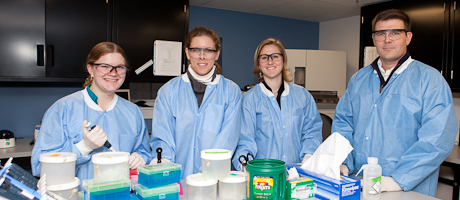Ten years ago, Daniele Podini was working in a crime lab in his native Italy, collecting and analyzing DNA evidence in homicides, robberies, kidnappings and sexual assaults.
Now in the basement of Somers Hall he’s working to make DNA analysis divulge more, including key information about people’s hair, eye and skin color and their ancestry.
If successful, it could enable crime investigators to develop a physical description of a suspect based on scant evidence, such as a few skin cells. It would also help identify human remains, especially in mass casualties.
“Forensic DNA analysis now doesn’t tell you much of anything,” said Dr. Podini, assistant professor of forensic molecular biology and of biological sciences.
With current methodology DNA can be compared to another sample—much like a fingerprint can—but, other than gender, the analysis doesn’t provide clues to a person’s physical appearance.
“If there’s no suspect to compare the profile to or if the profile doesn’t match any of the profiles in the database, it’s not useful,” said Dr. Podini.
Thanks to funding from the National Institute of Justice, Dr. Podini is in the second year of a two-year study that aims to develop a DNA investigative kit that can determine coloring and ancestry using existing crime lab technology.
Four graduate students in forensic science and biology are also working on the project, and the team is collaborating with the Armed Forces DNA Identification Laboratory and the National Institute of Standards and Technology, which maintains a comprehensive forensic DNA database.
Dr. Podini’s research focuses on examining certain gene sequence variations—called single-nucleotide polymorphisms, or SNPs—that play a role in human pigmentation and that indicate ancestry.
“The goal of the research is to select a panel of pigmentation and ancestry informative SNPs that can be typed with technology already present in crime laboratories,” said Dr. Podini. This would give investigators a new tool to help them prioritize suspect processing, corroborate witness testimony, better determine the relevance of a piece of evidence to a crime, and ultimately boost their ability to identify individuals related to the crime scene, he said.
The team has collected more than 250 DNA samples so far, and Dr. Podini says preliminary results are promising. Eye color has proven the most predictable trait, and the team has nearly 90 percent accuracy when it comes to inferring eye color from DNA.
He said predicting ancestry is more complex because many people have mixed racial and ethnic backgrounds. But, he said, the team is still “getting good results.”
Dr. Podini knows firsthand how valuable information on coloring and ancestry could be in crime investigations. Before coming to GW, Dr. Podini served in the Carabinieri, a national law enforcement force that is part of Italy’s military.
He worked in Rome on “any type of cases that involved DNA analysis, mostly homicides, rapes and other high-profile crimes,” he said.
“Every time it’s different, every scene is different, so you have to be able to adapt,” he said. The work was intense—people’s lives are hanging in the balance, he said—but also could be extremely tedious and detail oriented.
Above all, it was a rare opportunity as a scientist to make an immediate difference on people’s lives.
“I became really passionate about it, because it’s not often that a scientist gets to work on something that has an instant impact on society,” he said. “The next day someone can be arrested and is not going to commit another crime or the next day an innocent person can be set free from jail.”
After leaving the Carabinieri, Dr. Podini took a position with Genoma, a private laboratory based in Rome. He worked both in the genetic diagnostic section and in the forensic section consulting in criminal, paternity and immigration cases.
Dr. Podini joined GW in 2004 as a visiting professor and teaches courses in forensic biology and forensic molecular biology. “I’ve really enjoyed it,” he said. “The best thing is working with the students.”


